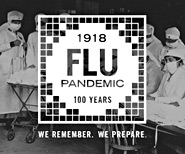Influenza and Zoonoses Education among Youth in Agriculture program
Each year, thousands of youth across the United States participate in agricultural fairs, often in association with 4-H (a hands-on learning and education program for kids) or Future Farmers of America (FFA). Many fairs have swine (pig) exhibitions, where pigs from different places come in close contact with each other and with people. These venues may be a place where diseases can spread between pigs and people.
One disease that can spread between pigs and people is influenza. Swine influenza is a respiratory disease of pigs. It is caused by influenza A viruses. Influenza viruses that circulate in swine are called “swine influenza viruses”. When these viruses are found in people, they are called “variant” viruses. Variant virus infections are rare in the United States. In recent years, most have occurred in people who have attended an agricultural fair and had exposure to pigs.
To prevent and better respond to variant influenza and other zoonotic diseases, the Centers for Disease Control and Prevention (CDC) established the Influenza and Zoonoses Education among Youth in Agriculture (Youth in Ag) program. This program is the only formal One Health collaboration between federal and state public health authorities and state youth agriculture groups focused on public health. It is designed to educate youth about zoonotic infections and deliver prevention and mitigation messages targeting these infections.
The Youth in Ag program is a joint collaboration with CDC, the United States Department of Agriculture (USDA)External, the Council of State and Territorial Epidemiologists (CSTE)External, selected state health departments and their state and local youth agriculture groups. Through this innovative project, human health, animal health and agricultural communities work together to promote more effective disease prevention and preparedness.:
What this program does to educate rural youth
- Improves participant awareness and knowledge of variant influenza virus infections and other zoonotic diseases, including zoonotic disease transmission and prevention.
- Motivates participants to adopt behavior that can help prevent zoonotic disease transmission.
- Increases participant awareness and knowledge of careers in public and animal health.
- Facilitates a better understanding of the roles public and animal health play in disease prevention.
- Develops relationships among stakeholders to facilitate more effective and efficient responses to important public and animal health issues (e.g., the response to infectious disease outbreaks).
- Fosters inter-state collaboration around youth zoonotic disease education to create a sustainable regional and national partnership network.
Timeline of Youth Agriculture Education Program
- 2011-2012 – In response to multiple outbreaks of human illness caused by influenza viruses that normally circulate in swine, CDC’s Influenza Division identifies opportunities to collaborate with youth agriculture organizations to raise awareness and mitigate risk of future outbreaks. The Division convenes colleagues from CDC and USDA to discuss the creation of a federal/state network of human and animal health authorities to partner with 4-H and other organizations on zoonotic disease education and prevention.
- 2012 – CDC and USDA pilot this partnership with Georgia 4-H. In less than two years, a curriculum is jointly developed and distributed by Georgia 4-H; the curriculum reaches 90,000 youth in the state during the first year.
- 2014 – CDC and CSTE fund six state and local health departments to launch state-level programs.
- 2016 – CDC and CSTE award additional funding to five of the six states funded in 2014 to build on their previous success and expand the project’s reach. This same year some county fairs in Michigan experience outbreaks of influenza A (H3N2) variant virus (also known as “H3N2v”). The existing partnership facilitates collaboration with youth agriculture clubs during the response.
- 2017 – CDC and CSTE award additional funding to four of the six states funded previously to further expand the project’s reach and to enhance evaluation efforts that will contribute to evidence-based policy changes. Two new states also received funding.
Awards to continue this work will be made by CSTE with a focus on regional collaboration.
Resources available: In 2017 CDC and CSTE created a resource library that includes state created in-depth online learning modules as well as posters, checklists, flyers and other print materials for fair settings. All content can be used or adapted freely: Influenza Education Among Youth in Agriculture Resource RepositoryExternal.
- USDA’s National Institute of Food and Agriculture (NIFA)External
- USDA’s Animal and Plant Health Inspection Service (APHIS)External
- Council of State and Territorial Epidemiologists (CSTE)External
- National Center for Immunization and Respiratory Diseases (NCIRD)
- National Center for Emerging and Zoonotic Infectious Diseases (NCEZID)
